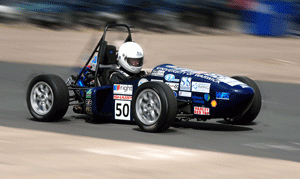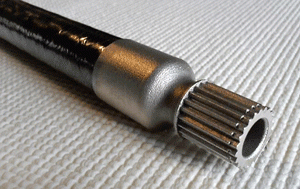Race car’s weight cut by 10% using laser sintered titanium, Inconel and Alumide
In this article, laser sintering machine manufacturer, EOS, reports on how additive manufacturing (AM) techniques have helped the University of Warwick, UK, reduce their car weight by 10% and achieve its best ever race position.
Organised by the Institution of Mechanical Engineers, UK, and backed by industry and high profile engineers, the Formula Student competition aims to inspire and develop enterprising and innovative young engineers. The University of Warwick has participated in the competition for the last ten years, and in 2010 achieved its best ever race position, thanks in no small part to extensive use of additive manufacturing (AM).
Laser sintering machine producer, EOS, has played a major role in helping the university to move up the field. Several years ago, an EOSINT P 380 was purchased to produce optimised plastic components for the race cars in short time frames. Then last year, for the first time, EOS in its role as technical partner contributed further by manufacturing and supplying laser sintered metal components.
The university is also fortunate to have on site WMG (formerly Warwick Manufacturing Group), which owns the EOS plastic processing machine installed in its International Manufacturing Centre. The group, which amongst other functions supports undergraduate and postgraduate projects, has also invested over the years in other AM machines. They include stereolithography and fused deposition modelling as well as EOS’ sand sintering technology for casting.
Principal Teaching Fellow, Dr Steve Maggs, said, “With the help of laser sintered components made from titanium alloy, Inconel and alumide, last year’s team managed to reduce the weight of the race car (fully fuelled) to 192 kg, 22 kg lighter than the previous year’s car.”
“The major advantage with AM is that the weight of each component can be optimised and parts can be produced quickly, late in the build process. The technology is perfect for concurrent engineering, which is essential for our students as each project time scale is relatively short, from October through to the following July” continued Maggs. “If parts are made in a rush shortly before the car is due to race, it will almost certainly add unnecessary weight, but this is avoided by exploiting the flexibility of layer-by-layer manufacture.”
“We hope to make more extensive use of AM in the coming years. With the help of new designs and materials, it should allow us to achieve our target race car weight of 150 kg.”
Lighter components and improved handling
In last year’s car, there were three main areas where AM lowered the weight of components compared with the 2009 model. First, titanium alloy and carbon fibre replaced hardened steel in the production of the half shafts driving the two front wheels. Second, Inconel was substituted for steel tubing when producing the exhaust header. Third, laser sintered alumide, an aluminium-filled polyamide 12 powder, was used instead of a casting or fabrication for the induction system.

Top: the original machined solid steel half shaft and below: the latest design based on laser sintered titanium end pieces gripping a carbon fibre tubular shaft
Driveshafts
Looking in more detail at the half shafts, their production used to be a headache for the university team, as finalisation of their design always came late in the build.
They were previously turned from hardened steel bar of approximately 20 mm diameter and then had a circlip groove and splines machined at both ends to mesh with the constant velocity (CV) joints. Replacing them in the 2010 car were shafts comprising end pieces with integral spines made from laser sintered EOS Titanium Ti64 alloy. They secured two ends of a 30 mm diameter, filament-wound, carbon fibre tubular shaft supplied by Crompton Technology Group.
David Cooper, who along with 11 other students chose the university’s Formula Student entry as his final year project, continues, “Changing from steel to titanium and carbon fibre cut the weight of each half shaft by 70%, from 1.35 to 0.4 kg, which amounted to a saving equivalent to one per cent of the car’s total weight. In addition, less energy is required to rotate the lighter shaft, allowing better use of the power generated by the 510 cc single cylinder engine (KTM 525).”
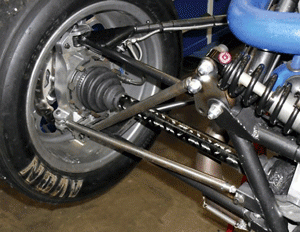
One of the new half shafts fitted to the University
of Warwick’s race car that was entered into the 2010
Formula Student competition
“It was notable that true net shape manufacture of the end pieces by EOS using its laser sintering technology resulted in a spline that fitted better than the previous machined version, with less play in the CV joints.”
He went on to say that the lead time for producing the shafts was two weeks but now that the process is established, they could be manufactured in a couple of days. This compares favourably with the six to eight weeks typically needed to machine the shafts from steel bar. The transmission was not only put through its paces at Silverstone last year but has also undergone well over 100 hours of road testing, without any loss of performance or other adverse effects.
Exhaust header
EOS Inconel 718 powder was laser sintered to produce the exhaust header, which is the first stage in the exhaust system and has to withstand high temperatures and vibration. Previously, the part was made by bending tubular steel sections on a mandrel and welding them together.
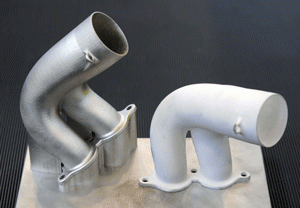
Left: the Inconel exhaust header produced by EOS
from a CAD model using AM technology and right:
the original plastic fit test part made in the EOSINT
P 380 by WMG/IMC.
Whereas the latter construction was of fixed wall thickness, the Inconel header has a section thickness that varies from 0.5 to 5.0 mm thanks to the application of HyperWorks modelling, analysis and simulation software from Altair Engineering. It allowed the volume of material in the header to be reduced, cutting the weight 40% while maintaining performance.
Cooper continued, “This benefit was only the start, as AM led to other significant improvements to the design of the car. The flexibility of design meant that the whole exhaust system could be redesigned and made shorter, leading to a total weight reduction from 4 to 3 kg.”
“We were also able to drop the exhaust, including the 2 kg silencer box, by 500 mm from the middle of the car to the bottom, lowering the centre of gravity and noticeably improving handling around the track.”
“F1 teams often make their exhaust manifolds by machining two blocks of Inconel and welding the halves together. So the weight and time saving AM technique, which produces a fully dense, corrosion resistant component that is robust and able to withstand high temperatures, may well be of interest to mainstream motor racing.”
Induction system – and other Alumide parts
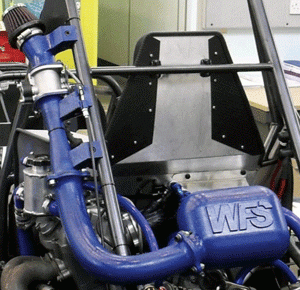
The lightweight induction system for the University
of Warwick’s Formula Student 2010 race car
was made by WMG from alumide powder using AM,
then porosity sealed and painted blue
It is difficult to optimise the shape and length of the car’s induction system early in a Formula Student project, so it is advantageous to leave finalising the design until the last minute. For the university’s entry last year, the plenum chamber and inlet runners were produced quickly from alumide powder in WMG’s EOSINT P 380.
Again, layer-by-layer manufacture from the CAD model gave design flexibility while the polyamide and aluminium mixture produced a stiff structure. Little post processing was needed and the component only needed porosity sealing and painting. Weight was cut to under 1 kg, significantly lighter than the cast and fabricated induction systems used in previous years.
Other components on the car, especially late-configurable items, were designed on the fly and made from alumide to reduce weight. They included boxes for the electrics, cable clips, dashboard panelling and the rear light brackets. Mr Cooper pointed out that smaller parts such as the clips were made inside the void of the plenum chamber to maximise use of the P 380’s build volume.
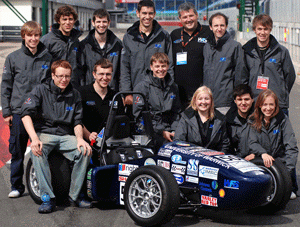
The undergraduate team at the University of
Warwick that designed and built the Formula
Student 2010 race car, with Principal Teaching
Fellow, Dr Steve Maggs, pictured back row, third
from right
Not only do the Formula Student judges assess each car’s speed, manoeuvrability and endurance, but they also appraise cost, business potential and aesthetics. In the latter respect AM has a big contribution to make, as it does not matter how complex a part is – it will be just as easy to manufacture as a simple one – so the degree of design freedom is almost limitless. Similarly, it is immaterial if each clip, say, is slightly different from the next, as there is no penalty in manufacturing cost or time.
Described as a breeding ground for world class engineers, Formula Student’s key aims are to inspire the next generation and address the skills shortage. It achieves this by providing crucial practical experience and transferable skills that can be used in a diverse range of industries. AM is a core technology that is destined for growth across all sectors.
News | Articles | Market reviews | Search directory | Subscribe to e-newsletter
Published on www.ipmd.net
News, articles and a fully searchable directory for the powder metallurgy industry



